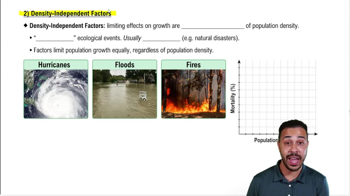Here are the essential concepts you must grasp in order to answer the question correctly.
Carrying Capacity
Carrying capacity refers to the maximum number of individuals of a species that an environment can sustainably support without degrading the habitat. For humans, this concept is influenced by resource availability, technology, and consumption patterns. Understanding carrying capacity is crucial for evaluating the sustainability of human populations and their impact on the planet.
Recommended video:
Estimating Earth’s Human Carrying Capacity
Demographic Momentum
Demographic momentum is the phenomenon where a population continues to grow even after fertility rates decline, due to a large proportion of individuals in reproductive age. This can lead to an inflated perception of carrying capacity, as the population may still increase despite efforts to control growth. Recognizing demographic momentum is essential for understanding population dynamics and future projections.
Recommended video:
Density-Independent Factors
Density-independent factors are environmental influences that affect population size regardless of the population's density, such as natural disasters, climate change, and resource availability. These factors can significantly impact the carrying capacity of an environment by altering the conditions under which populations thrive. Understanding these factors helps in assessing the resilience and sustainability of human populations.
Recommended video:
Density-Independent Factors




